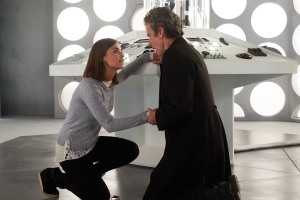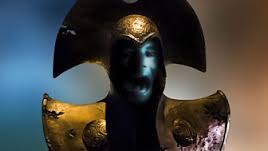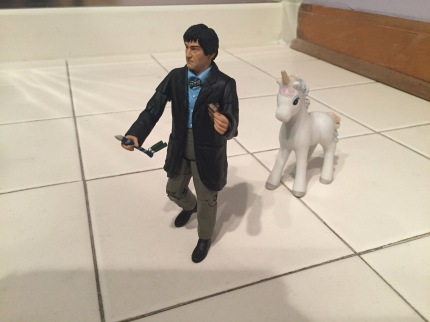“Nothing’s sad ’til it’s over, then everything is.” While the Doctor delivers these lines to Clara early in “Hell Bent,” I can’t help but feel that these lines express Steven Moffat’s feelings (and I would assume RTD’s feelings) about endings as well. Every parting in the new series of Doctor Who is an emotional, heart-wrenching goodbye. Endings are filled with sadness. However, this episode is a bit less bleak of an ending than some; it puts a bittersweet coda on the exit of Clara Oswald. Don’t worry though, there was still plenty of sadness to go around.

The Doctor says his goodbye to Clara
Overall, I found the episode a bit uneven, but what I found really stuck with me was the dialogue. Therefore, I’ve decided to approach this episode through a series of memorable and/or important quotes.
“I heard the Doctor had come home. One so loves fireworks!”
Honestly, except for the parts with the Doctor and Clara in the diner, which I’ll get to later, the first 20 or so minutes dragged for me. Maybe that’s because I just kept wondering why the Doctor seemed to grow up in the Dust Bowl. Who is the woman in the barn (which makes its third appearance on the show, after “Day of the Doctor” and “Listen”)? If the Doctor is a high-born Gallifrean, than why does his childhood home feel like an orphanage?
I did enjoy the touch of the Doctor dropping his spoon when told to put down any weapons (nice callback to “Robot of Sherwood”). It was a bit amusing to see how the Doctor just utterly ignored everyone until the president himself came (and interesting to see him draw a literal line in the sand), but overall it felt like filler. Why did the Doctor have to wait too long for everyone to turn on Rassilon? Was it just to have that old west showdown kind of feel to their meeting? The powerful Rassilon comes across more like a petulant child, which doesn’t make him seem like the best leader. How did he get everyone to listen to his idea to trap the Doctor in his confession dial? The door is clearly left wide open for a possible return of Rassilon, but I won’t be waiting with bated breath.
I did however, enjoy the return of Ohila. I’m not clear how she got there, but it was kind of amusing to see her and the Sisterhood just barge in on the Gallifrey high command and make snarky comments. Apparently at the end of things one should expect immortals there to heckle you. Of course, she is also there to let the Doctor know that he is going too far. She accuses him of being cruel or cowardly by banishing Rassilon and the rest of the High Council, which is basically saying that he has stopped being the Doctor again. I’d love to see the Sisterhood used in a more meaningful way again, but I enjoyed their appearance here.

Everyone finally turns on Rassilon
“Stories are where memories go when they’re gone.”
As I mentioned previously, the part of the beginning that I did enjoy was the scenes in the diner between the Doctor and Clara. I enjoyed the way that those scenes played with my expectations. It began and I thought the Doctor was checking on Clara who no longer remembered their experiences. However, right from the start Moffat put in clues that Clara knew more than she was letting on; the example that jumps to mind is when the Doctor’s guitar starts to play (a guitar version of Clara’s theme, no less) on the diner’s speakers. Clara doesn’t even react, which immediately made me start to suspect that she knew exactly who the Doctor was.
“You like a cliffhanger, don’t you?”
Another quote from the scenes in the diner, but I just had to include it because it made me chuckle. I do love the meta-commentary on the shows abundant use of cliffhangers.
“Back to normal, am I? Only time I’ve been a man, that last body. Dear lord, how do you cope with all that ego”
At this point the story picks up a bit, although, let’s face it, this episode isn’t really a terribly plot-heavy episode. The Doctor learns what the Time Lords know about the hybrid from the General before demanding the use of the extraction chamber to save Clara. The scene between the Doctor, Clara, and the General was where the episode began to pick up for me. Clara remains Clara, observant and clever even though she is terribly confused and I really enjoyed Peter Capaldi’s performance. The look on his face as he let the General offer Clara explanations made it clear that he was about to do something that he knew he really shouldn’t.
I really enjoyed the General throughout the episode. While Ken Bones played the General, he was almost the lone voice of reason among the Time Lords, proof that they were not all corrupted. I was enjoying his performance so much that I was a bit disappointed when he started to regenerate (I did like that the Doctor checked to make sure that the General wasn’t out of regenerations before shooting. I guess that’s Time Lord courtesy). However, I was pleasantly surprised to see the General regenerate into T’Nia Miller, a black woman. First, I liked that the show was taking the traditionally male role of a general and suggesting that it was traditionally held by a woman. Plus, let’s face it, most Time Lords that we see on screen are male. I enjoyed the fact that Steven Moffat clearly wanted to depict on-screen that Time Lords can change their race and gender at any time. The quote above even shows that he was specifically making the point that a Time Lord can be one gender for all of his or her regenerations and then suddenly be regenerated as the other gender.
On a side note, when I was double checking the names of the actors who played the General, I was very disappointed to see that the credits bill Ken Bones as the General and T’Nia Miller as the female General, as if normal is male and female is an exception. I’m a bit disappointed that the show would label the characters in such a carelessly sexist way, especially after what seemed to be a move against sexism.

The General, Gastron, and Ohila try to figure out what is the Doctor’s plan.
Trying to figure out exactly what was going on in the cloisters was enough to make my head spin. I remember the matrix from the classic series, but it has clearly been majorly upgraded since then. I could have used a bit less of the slightly confusing cloisters in this episode as well. The random Dalek, Cyberman, and Weeping Angels didn’t really seem necessary, and I’m a bit fuzzy on what the Cloister Wraiths were protecting (since all we really saw were corridor-like rooms, but the Cloister Wraiths looked cool. They were a striking visual as they glided around with their flickering screen, screaming faces. As for the rest of it, I’m going with the Doctor’s handy cheat sheet for Clara and the audience before I develop a headache.

One of the creepy Cloister Wraiths.
The heart of the episode was the relationship between the Doctor and Clara. This being Jenna Coleman’s final episode, Clara does get her share of moments, even though her role in the beginning of the episode was limited to her scenes in the diner. I was happy to see that this episode did not deminish Clara’s bravery in “Face the Raven.” She continues to accept that it is her time to go, trying to convince the Doctor that her life wasn’t worth fracturing all of time. And I loved seeing her face off against Ohila and the General, distracting them while the Doctor stole another TARDIS. I also can’t let that pass without mentioning how excited I was to see the original console room.
The moment that really stuck with me however, was the conversation between Clara and the Doctor in the cloister. It’s played perfectly by both Peter Capaldi and Jenna Coleman. Without even saying a world, it’s clear how well these two characters know each other. Clara sees a change in the Doctor and realizes that he has been through a lot since she last saw him. He knows that if he looks at her she will read the pain in his eyes, so he tries to look away, to not let her see. Once again they are both trying to look out for the other. Clara’s reaction when she learns that the Doctor spent 4 1/2 billion years trapped in his confession dial solely to bring her back from the dead shows that she is both incredibly moved and angry at the same time. And somewhere Adric just cried.
“Even the other immortals are gone, it’s just Me.”
It’s not until the final third of the story that Me enters the episode. Once again Maisie Williams does a great job of giving Me a slightly different, almost wiser air as she can appreciate the beauty in sad events, something the Doctor seems incapable of doing. She’s a bit underused in this episode, basically popping up to become Clara’s companion in the end, but she makes the most of her limited screen time, even if she does essentially disappear during the Doctor and Clara’s farewell in the TARDIS.
I’m also going to admit that Steven Moffat got me again when the Doctor said it was “me” knocking. The Doctor has been to the end of the universe several times; it seems impossible that he wouldn’t run into himself there. I held out hope for a moment that maybe, just maybe, it was Orson Pink and Moffat had found a way to explain his existence, but no such luck.

Clara and her companion head off to Gallifrey, the long way round
“By your own reasoning, why couldn’t the hybrid be half Time Lord, half human?”
The other reason Me seemed to exist in this episode was to troll the audience. As she started this speech, I was thinking, he’s not actually going there, is he? And of course, he didn’t, not really. Moffat actually leaves the whole hybrid thing a bit unclear although it does seem that the prophecy must refer to the Doctor since he is the one willing to destroy a billion hearts to heal his own. Still all three of the possibly hybrids are, at that moment, standing in the ruins of Gallifrey, so there really isn’t a definitive answer.
“Nobody’s ever safe. I never asked you for that, ever…These have been the best years of my life and they are mine. Tomorrow’s promised to no one, Doctor, but I insist upon my past. I am entitled to that.”
This was my favorite moment of the episode. I loved seeing Clara stand up to the Doctor and tell him that he did not have the right to take away her memories. It felt like a bit of a redemption for the horrible ending that RTD gave Donna (I really, really, really hated that memory wipe). And considering that Clara was willing to face her death and put an end to all of this, it was clear that it was the Doctor who really needed the memory wipe. I think he realized this as well. I’m pretty sure that he knew that Clara had managed to reverse the polarity, and he accepted it as a consequence of his going too far this time.
He and Clara’s final moments were touching, as he basically told her how to be a Doctor, which seemed to indicate that he had some idea of what she might do. I happen to love pears, so I’m disregarding that part of his advice, but the rest of it was sound. I will admit that I love the idea of Clara and Me traveling around the universe, even though it once again allows a death to not really be a death on Doctor Who.
“When something goes missing, you can always recreate it by the hole it left.”
I’ve heard many interpretations of the final scene in the diner. Personally, I think the Doctor really doesn’t know that it is Clara to whom he’s speaking. At first I wasn’t sure why Clara wanted him to know that it was her, but I think I’ve figured out an explanation that works for me. Time and time again we’ve seen Clara looking out for others; I think this was her final act of looking out for the Doctor. One of the last things she asks him is if he’s going to look for Clara, and he seems to want to find her again. I think Clara wanted to plug up the hole a bit, so that he wouldn’t waste time trying to find her or wondering about her. By making her TARDIS dematerialize around him, she let him know that he had been talking to Clara and that she was okay. This was so he wouldn’t feel the need to search for her.

Clara takes a final look back at the Doctor (as Elvis watches)




















